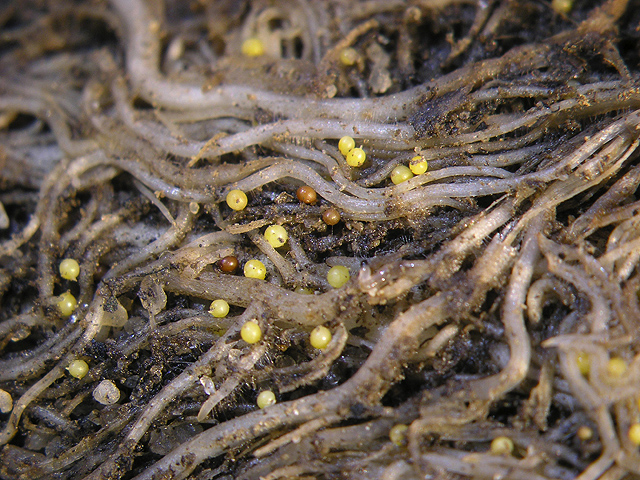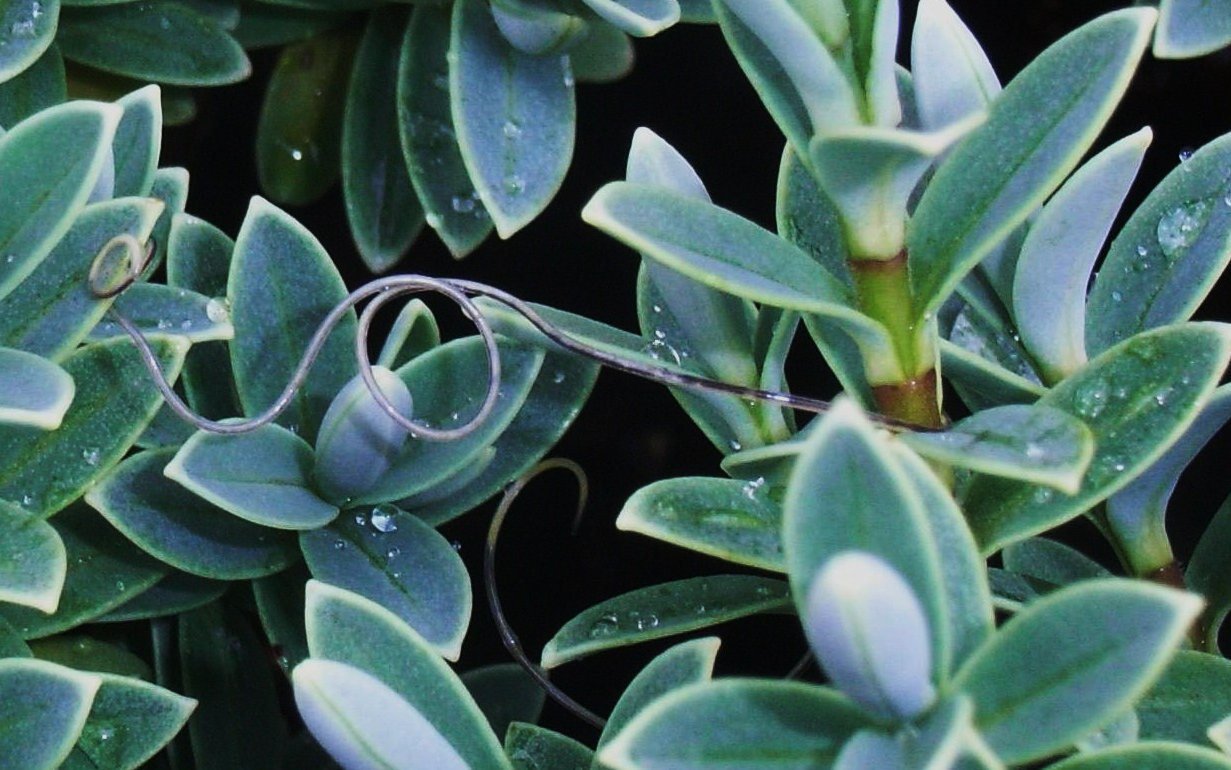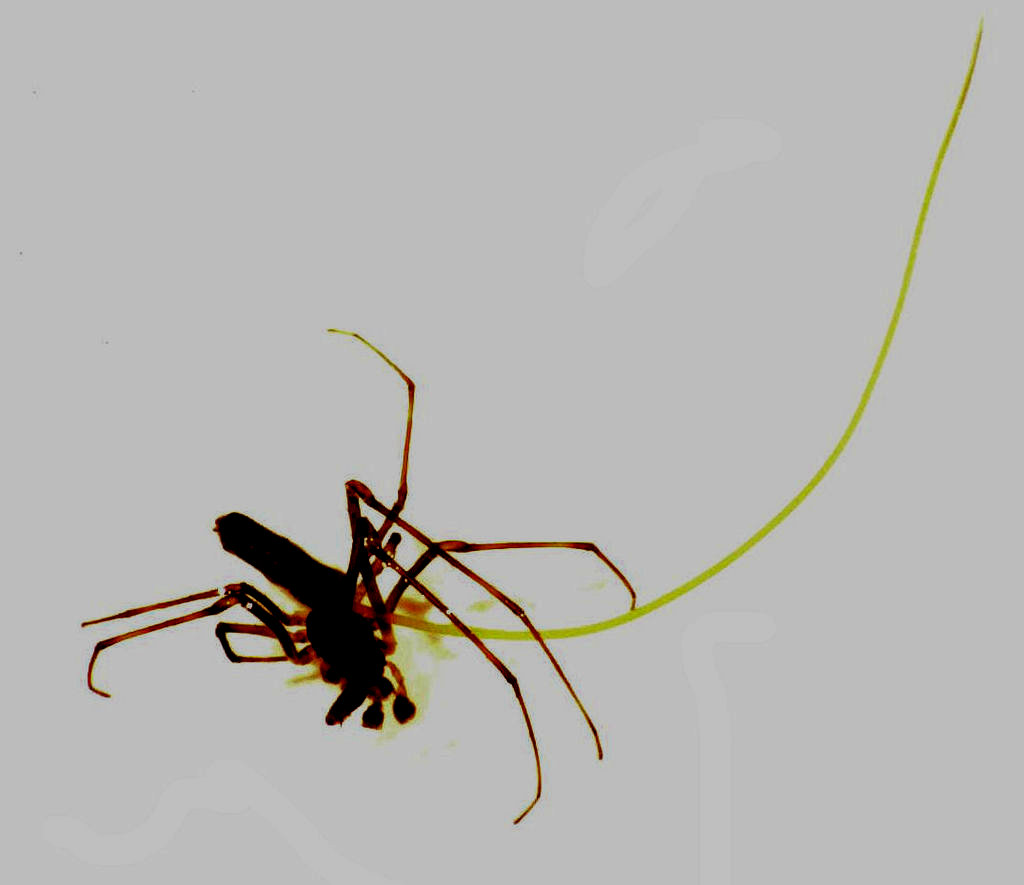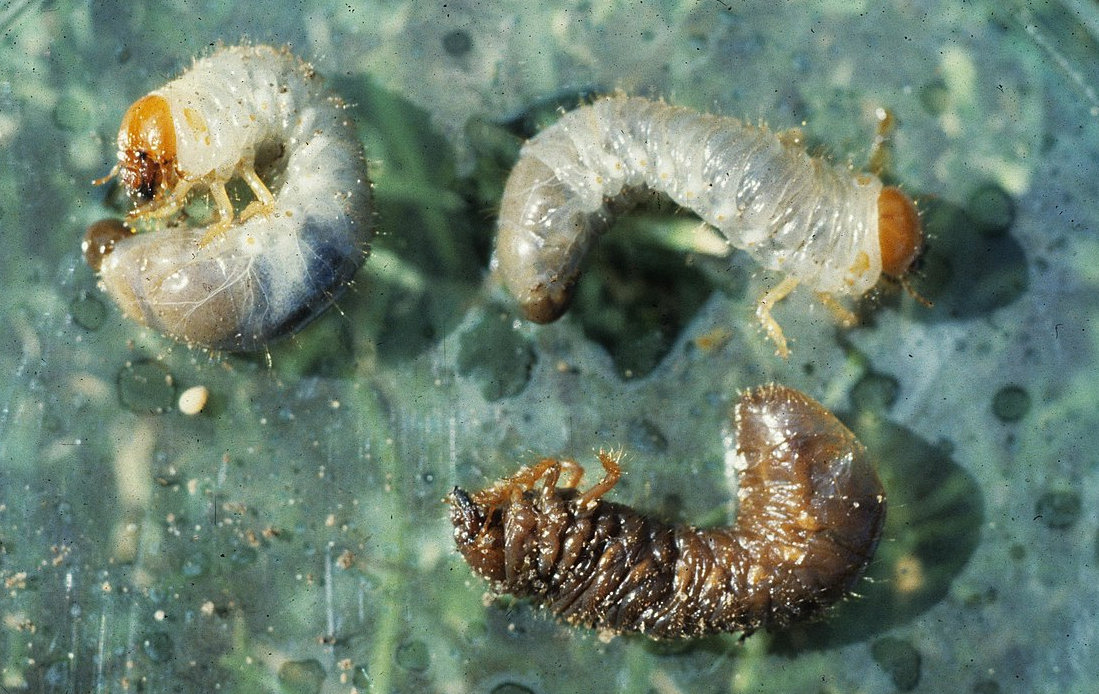- Home
- Garden Wildlife
- Roundworms
- Nematodes
Nematode worms
The Nematoda is an animal phylum also known as eelworms or roundworms. They are worm-like animals with unsegmented bodies. They move by bending their bodies from side to side in an eel-like manner, hence the common name of ‘eelworm’. Most are of microscopic size but they can be extremely numerous and have an impact in gardens.
Species in Britain and Ireland
The nematode fauna of Britain and Ireland is relatively poorly understood and there is no reliable estimate of the number of species. It is likely to exceed a thousand species. They include some very tiny species (1mm long) which can damage garden plants, such as potato cyst eelworms, Globodera rostochiensis and Globodera pallida and Ditylenchus dipsaci which is the eelworm for phlox, narcissus and onion. The leaf and bud eelworms are Aphelenchoides ritzemabosi and Aphelenchoides fragariae. There are also several beneficial nematodes that can be used as biological controls for pests such as slugs, vine weevil grubs, chafer grubs and leatherjackets.
Nematodes, especially the small garden species are dreadfully hard to distinguish because they all look much the same. This microscope study of the soil nematode Caenorhabditis elegans below will serve as a picture of them all. This nematode has been hugely important as a lab animal in decyphering the processes and genetic mechanisms of embryological development.
Predatory species Some nematodes prey on microfauna in the soil, including other nematodes.
Animal parasites Some larger species live inside the gut of birds and mammals, including humans. They attach themselves to the gut lining and absorb nutrients provided by the host animal’s digestive system. Other nematodes develop as parasitoids inside insects and spiders. Mermis species develop inside the bodies of plant-feeding insects, such as grasshoppers and caterpillars, which ingest nematode eggs that have been laid on the foliage. Mermis species are commonly called thunderworms as they are sometimes seen writhing on plants during wet weather in early summer. Wet weather allows the adults, which can be up to 70mm long, to emerge from the soil and lay their eggs on foliage. Emerging Mermis can be confused with nematomorphs which have very similar habits, but these are darker and don't have tapered ends to their body.


.jpg)
Biology
Nematodes occupy a very wide range of ecological niches. The main categories are:
Bacterial feeders These are microscopic nematodes that live in the soil, leaf litter and other damp places and contribute to decay processes and nutrient recycling.
Fungal feeders These microscopic nematodes feed on fungal mycelium in the soil
Internal plant feeders These nematodes feed and develop inside the leaves, stems, bulbs or roots of various plants. They can cause distorted growth or progressive necrosis of the foliage as infestations develop within the plant, although these symptoms are not always evident. Most plant-feeding nematodes are of microscopic size but the spherical egg-filled bodies, known as cysts, of potato cyst eelworms are 1mm in diameter when mature.
.jpg)
Left: yellow cysts of potato eelworm Globodera rostochiensis. Right: Eelworm damage on bean leaf.
External plant feeders These are microscopic free-living nematodes that live in the soil and feed on plant roots. They include Trichodorus, Xiphinema and Pratylenchus species.
Nematode Pratylenchus penetrans feeding from a root hair. It is practically transparent, and you can see the sharp piercing stylet in its pharynx which it uses to penetrate the root.
Life cycle
Nematodes lay eggs that hatch into small versions of the adult animal. Eggs of potato cyst eelworms can remain dormant inside the cysts, which are the hardened bodies of dead females, for several years in the absence of suitable host plants. When potatoes or tomatoes are planted in infested soil, chemical emanating from the plant roots stimulate the eggs to hatch. Many nematodes will have numerous generations a year and will breed continuously while conditions remain favourable.
Role of nematodes in gardens
From the gardener’s point of view, there are good, bad and neutral nematodes in gardens. Those nematodes that help control certain soil-dwelling pests are welcome. However, the nematodes that feed within plant tissues can be very damaging.
Most nematodes, such as those that feed on bacteria and fungi, have little direct impact on gardens but the vast numbers of nematodes means that they are a significant part of the animal biomass in soil, leaf litter and compost heaps.
Because of the long persistence of potato cyst eelworms eggs, it can become impossible to grow worthwhile crops of potatoes once a damaging infestation has built up in the soil. Phlox eelworm causes stunted swollen shoots with leaves at the shoot tips drastically reduced in width. Narcissus eelworm causes stunted growth and causes the bulbs to rot. Leaf and bud eelworms damage the foliage of a very wide range of plants, causing brown dead patches between the leaf veins. Chrysanthemum, Japanese anemones, Penstemon, foxglove, Buddleja and ferns are frequently damaged.
Free-living nematodes that feed on roots kill the fine root hairs and can cause stunted growth on a wide range of plants. They can also transmit some plant virus diseases, especially of soft fruits, such as strawberry and raspberry.
Other sources of information
Websites
Information on nematodes available as biological controls
Books
Goodey, J.B. (1963) Soil and Freshwater Nematodes. John Wiley & Sons
Perry, R. N. & Moens, M. (2013) Plant Nematology. CABI Publishing
Page text drafted by Andrew Halstead, reviewed by Andrew Salisbury, compiled by Steve Head
Left: Mermithid nematode, probably Mermis nigrescens, active on a Hebe Right:Mermithid nematode emerging from spider
Pathogenic nematodes Some nematodes enter the bodies of soil-dwelling insect larvae or slugs. They release bacteria that cause a form of septicaemia, killing the host animal and allowing the nematodes to feed on the bacteria multiplying in the rotting corpse. Some of these species can be purchased as biological controls of certain pests. For example Steinernema kraussei is used against vine weevil grubs, Heterorhabditis bacteriophora against chafer grubs, Steinernema feltiae against leatherjackets and Phasmarhabditis hermaphrodita against slugs. With the withdrawal of metldehyde slug pellets, nematode slug control has become a method of choice. Larval Rhabditis species parasitise earthworms, but only develop to adults when the worm dies. Rhabditis terricola has been identified as a parasitoid in cocoons of earthworms.


.jpg)

Left: Chafer grub killed by Heterorhabditis bacteriophora with two healthy grubs. Right: Phasmarhabditis hermaphrodita
Nematode worms
The Nematoda is an animal phylum also known as eelworms or roundworms. They are worm-like animals with unsegmented bodies. They move by bending their bodies from side to side in an eel-like manner, hence the common name of ‘eelworm’. Most are of microscopic size but they can be extremely numerous and have an impact in gardens.
Species in Britain and Ireland
The nematode fauna of Britain and Ireland is relatively poorly understood and there is no reliable estimate of the number of species. It is likely to exceed a thousand species. They include some very tiny species (1mm long) which can damage garden plants, such as potato cyst eelworms, Globodera rostochiensis and Globodera pallida and Ditylenchus dipsaci which is the eelworm for phlox, narcissus and onion. The leaf and bud eelworms are Aphelenchoides ritzemabosi and Aphelenchoides fragariae. There are also several beneficial nematodes that can be used as biological controls for pests such as slugs, vine weevil grubs, chafer grubs and leatherjackets.
Nematodes, especially the small garden species are dreadfully hard to distinguish because they all look much the same. This microscope study of the soil nematode Caenorhabditis elegans below will serve as a picture of them all. This nematode has been hugely important as a lab animal in decyphering the processes and genetic mechanisms of embryological development.

Biology
Nematodes occupy a very wide range of ecological niches. The main categories are:
Bacterial feeders These are microscopic nematodes that live in the soil, leaf litter and other damp places and contribute to decay processes and nutrient recycling.
Fungal feeders These microscopic nematodes feed on fungal mycelium in the soil
Internal plant feeders These nematodes feed and develop inside the leaves, stems, bulbs or roots of various plants. They can cause distorted growth or progressive necrosis of the foliage as infestations develop within the plant, although these symptoms are not always evident. Most plant-feeding nematodes are of microscopic size but the spherical egg-filled bodies, known as cysts, of potato cyst eelworms are 1mm in diameter when mature.

.jpg)
Left: yellow cysts of potato eelworm Globodera rostochiensis. Right: Eelworm damage on bean leaf.
External plant feeders These are microscopic free-living nematodes that live in the soil and feed on plant roots. They include Trichodorus, Xiphinema and Pratylenchus species.
.jpg)
Nematode Pratylenchus penetrans feeding from a root hair. It is practically transparent, and you can see the sharp piercing stylet in its pharynx which it uses to penetrate the root.
Predatory species Some nematodes prey on microfauna in the soil, including other nematodes.
Animal parasites Some larger species live inside the gut of birds and mammals, including humans. They attach themselves to the gut lining and absorb nutrients provided by the host animal’s digestive system. Other nematodes develop as parasitoids inside insects and spiders. Mermis species develop inside the bodies of plant-feeding insects, such as grasshoppers and caterpillars, which ingest nematode eggs that have been laid on the foliage. Mermis species are commonly called thunderworms as they are sometimes seen writhing on plants during wet weather in early summer. Wet weather allows the adults, which can be up to 70mm long, to emerge from the soil and lay their eggs on foliage. Emerging Mermis can be confused with nematomorphs which have very similar habits, but these are darker and don't have tapered ends to their body.


Left: Mermithid nematode, probably Mermis nigrescens, active on a Hebe Right: Mermithid nematode emerging from spider
Pathogenic nematodes Some nematodes enter the bodies of soil-dwelling insect larvae or slugs. They release bacteria that cause a form of septicaemia, killing the host animal and allowing the nematodes to feed on the bacteria multiplying in the rotting corpse. Some of these species can be purchased as biological controls of certain pests. For example Steinernema kraussei is used against vine weevil grubs, Heterorhabditis bacteriophora against chafer grubs, Steinernema feltiae against leatherjackets and Phasmarhabditis hermaphrodita against slugs. With the withdrawal of metldehyde slug pellets, nematode slug control has become a method of choice. Larval Rhabditis species parasitise earthworms, but only develop to adults when the worm dies. Rhabditis terricola has been identified as a parasitoid in cocoons of earthworms.

.jpg)
Above: Phasmarhabditis hermaphrodita
Left: Chafer grub killed by Heterorhabditis bacteriophora with two healthy grubs.
Life cycle
Nematodes lay eggs that hatch into small versions of the adult animal. Eggs of potato cyst eelworms can remain dormant inside the cysts, which are the hardened bodies of dead females, for several years in the absence of suitable host plants. When potatoes or tomatoes are planted in infested soil, chemical emanating from the plant roots stimulate the eggs to hatch. Many nematodes will have numerous generations a year and will breed continuously while conditions remain favourable.
Role of nematodes in gardens
From the gardener’s point of view, there are good, bad and neutral nematodes in gardens. Those nematodes that help control certain soil-dwelling pests are welcome. However, the nematodes that feed within plant tissues can be very damaging.
Most nematodes, such as those that feed on bacteria and fungi, have little direct impact on gardens but the vast numbers of nematodes means that they are a significant part of the animal biomass in soil, leaf litter and compost heaps.
Because of the long persistence of potato cyst eelworms eggs, it can become impossible to grow worthwhile crops of potatoes once a damaging infestation has built up in the soil. Phlox eelworm causes stunted swollen shoots with leaves at the shoot tips drastically reduced in width. Narcissus eelworm causes stunted growth and causes the bulbs to rot. Leaf and bud eelworms damage the foliage of a very wide range of plants, causing brown dead patches between the leaf veins. Chrysanthemum, Japanese anemones, Penstemon, foxglove, Buddleja and ferns are frequently damaged.
Free-living nematodes that feed on roots kill the fine root hairs and can cause stunted growth on a wide range of plants. They can also transmit some plant virus diseases, especially of soft fruits, such as strawberry and raspberry.
Other sources of information
Websites
Information on nematodes available as biological controls
RHS factsheet on potato cyst eelworms
RHS factsheet on leaf and bud eelworm
RHS factsheet on stem and bulb eelworm
Books
Goodey, J.B. (1963) Soil and Freshwater Nematodes. John Wiley & Sons
Perry, R. N. & Moens, M. (2013) Plant Nematology. CABI Publishing
Page text drafted by Andrew Halstead, reviewed by Andrew Salisbury, compiled by Steve Head












